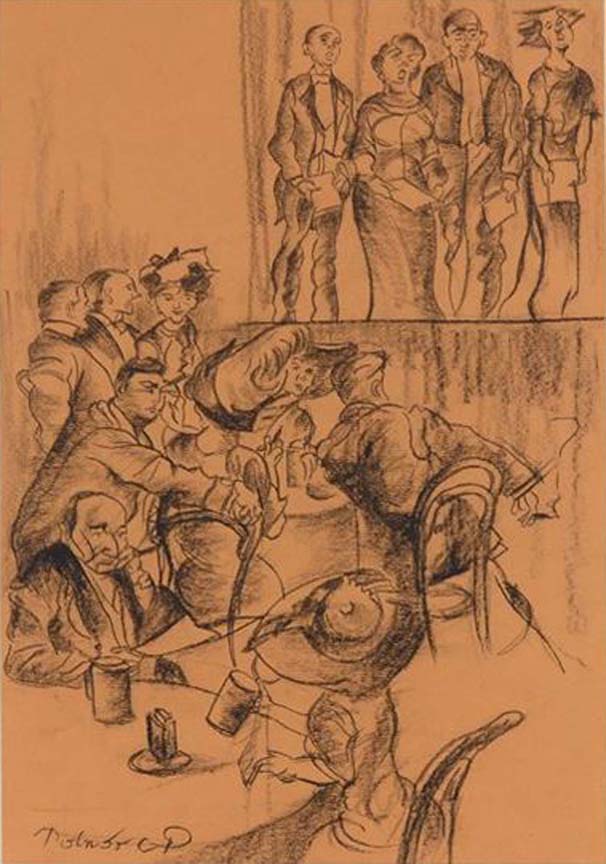

PAL C. MOLNAR
"CABARET"
DRAWING, SIGNED
HUNGARIAN, WORKED IN PARIS, C.1925
16.5 X 11.5 INCHES
Pal C. Molnar 1894-1981 Painter and graphic artist Pal Molnar was born in Hungary in 1894. He studied in Budapest from 1915-1918 to become an art teacher, learning various techniques, which led to the diversity displayed in all his chosen mediums. As a private teacher, he traveled with the Szinyei family to Switzerland, and later spent a year in France before returning to Hungary in 1923. He spent three years in Rome on a fellowship. Characteristic of his art is a combination of classical Mediterranean traditions and the restlessness of 20th century man. The mostly sacral scenes of his pictures, identical with subject matters of the Rome school, are portrayed in a direct sensual style. In the 1920s, he created a richer version of plein air painting, as seen in the stronger colors in his Swiss landscapes. In his drawings and character drawings, thorough observations were accompanied by stylization, cubistic characterization and expressionism. Portrayal, color and a penchant for surrealism created a peculiar version of neo-classicism in his ecclesiastical pictures and frescoes. In 1935 the artist Paul Molnár was made an honorary freeman of his birthplace, the town of Battonya in southeast Hungary. Born there on 28 April 1894, he later took the initial ‘C’ from the surname of his French-born mother, Jeanne Contat, as his professional signature, signing his works ‘MCP’. After learning in schools of Battonya and Arad, Mr. Molnár studied at the Academy of Fine Arts in Budapest before he went to Switzerland in 1918, where he was influenced by Hodler. His exhibitions there (two in Lausanne and one in Geneva) were favourably received and many pictures were sold. In 1921 he studied in Paris, and in 1923 he held his first Budapest exhibition: he began his ecclesiastical works in 1916. From 1924 Mr. Molnár was employed by three newspapers in the largest Hungarian press concern to make daily drawings for their publications, under the title ‘Daily Life’. He lived in Italy from 1928 to 1931 as a scholar of the Hungarian Academy of Rome. He returned to Budapest in 1931, where he married Alice Gästettner. He held numerous exhibitions if his work in Hungary, Germany and Switzerland, France. He participated in international exhibitions including the Venice Biennale eight times and others in Italy, Germany, the United States, Norway, Switzerland, England and others, and participated as a member in all exhibitions of the Copperplate Engravers Society. Mr. Molnár was also active in the New Society of Artists, the Paul Szinyei Merse Society, National Salon Association, Munkácsy Guild, and the Fészek Seat Artists Club; he also belongs to the Saint Stevens Academy, Budapest; Accademia Adriatica d’Italia; Österreichescher Kunstler Bund and Accademia delle Arti e del Lavoro. He took part in all the most significant exhibitions of church art, graphic art and poster art in Hungary between the years of 1925 and 1943, and was invited to design the poster for the Eucharistic Congress of 1938. His works can found in the City Museum of München; Museo di Arte Moderna, Rome; Museo della Biennale of Venice; New York Museum of Modern Art; City Museum of Chicago; the City Museum of San Francisco and Newcastle; the Laing Art Gallery, Edinburgh; and Budapest National Gallery. Amongst his numerous book illustrations are woodcuts of the Flowers of Saint Francis; Shakespeare’s ‘Corialanus’; and Rostrand’s ‘Cyrano de Bergerac’, which gained gold medals in Paris, Milano and Warsaw. His larger works include paintings, frescoes and at least 30 paintings for churches and public buildings of Budapest and Hungary. Mr. Molnár has been mentioned in nearly 40 biographical works and artistic journals, published in all part of Europe and the United States. SOME OF THE AWARDS HE HAS GAINED 1929. Monza, Gold Medal 1929., 1931. and 1933. Padua ecclesiastic Prizes 1930. Budapest, Zichy Mihály Graphic Prize for Fiorettis illustration 1930., 1933., 1936. and 1937. Gold Medals for Graphic and Paintings Milano (Triennale) 1930., 1934. and 1938. Warsaw, Diplome d’Honeur, Gold Medals for painting and a special prize at the Graphic Biennale (1934 for Cyrano) 1934. Budapest. The highest painting award of the Paul Szinyei Merse Society 1934. Budapest, Franz Joseph’s Jubilee Prize 1936. New York, on a competition for illustration I. Prize 1937. Paris, World Exhibition, Grand Prix, 2 Gold Medals and Diplome d’Honneur 1937. Monza, Gold Medal for a new invention (Metalographia) 1938. Warsaw, Gold Medal for the wood cut ”The 2 eagles” 1939. Pope Pius XII. presented “Pro Ecclesia et Pontifice” Golden Cross 1941. Budapest, Gold Medal for his ecclesian works 1946. “Nancy, Diplome d’Honneur for Ex Libris and Book Illustrations”
|